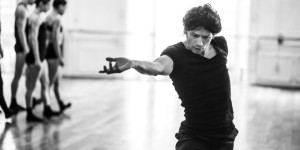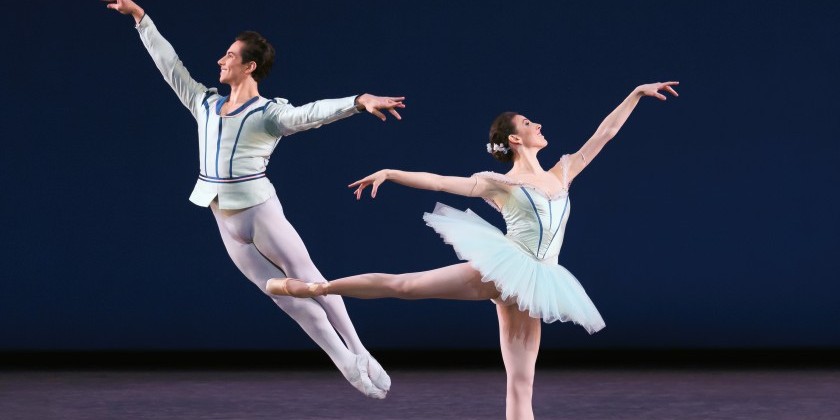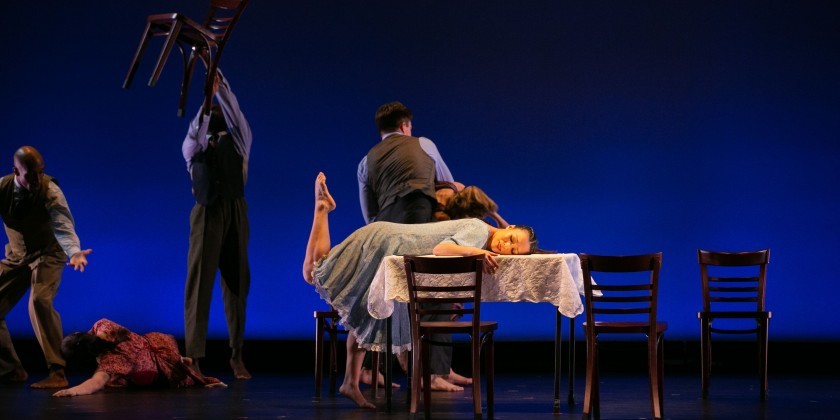IMPRESSIONS: "Sw!ng Out" at The Joyce Theater, Conceived and Directed by Caleb Teicher

With Collaborators Evita Arce, LaTasha Barnes, Nathan Bugh, Macy Sullivan and Eyal Vilne
Direction: Caleb Teicher
Creative Team: Evita Arce, LaTasha Barnes, Nathan Bugh, Macy Sullivan, Caleb Teicher, Eyal Vilner
Choreography and Improvisation: Caleb Teicher, Evita Arce, LaTasha Barnes, Nathan Bugh, Macy Sullivan, Frankie Manning, Remy Kouakou Kouame, Ramona Staffeld, and Dancers
Dancers: Evita Arce, LaTasha Barnes, Nathan Bugh, Gaby Cook, Laura Glaess, AJ Howard, Michael Jagger, Jennifer Jones, Brian Lawton, Dee Daniels Locke, Joshua Mclean, Caleb Teicher
Music: Performed by Eyal Vilner Big Band // Lighting Design: serena wong
Costume Design: Márion Talán // Sound Design: Joseph Wolfslau
The most entertaining dance concert I’ve seen in years, Sw!ng Out, playing at the Joyce Theater from October 5-17, is a zealous celebration of swing dance. Spawned in African-American communities, the vernacular social-dance form is rooted in the daring Lindy Hop of the 1920s, was popularly danced to Swing Era jazz music in the 1930s and 1940s, and then adapted by jitterbugging teens in the 1950s, who set its nifty footwork and acrobatic partnering to early rock ‘n’ roll.
.png)
Fans of swing music and its richly-orchestrated, brassy, Big Band sound will find this show’s music alone worth the price of admission. Situated on platforms across the back of the stage, the 10-member Eyal Vilner Big Band fuels the evening with electrifying renditions of jazz and pop standards, as well as original tunes by Eyal Vilner. Sprinkled throughout the exuberant ensemble playing are inspired solos improvised by individual musicians. After a particularly delicious one by trombonist Ron Wilkins, I wanted to applaud, but, this being a dance crowd, we weren’t doing that jazz-audience thing of clapping after each instrumentalist’s solo.
The band’s silky-voiced vocalist, Imani Rousselle, also warrants special applause. Amidst all the activity, she projects a calm warmth as she sings from her spot on the bandstand, stylishly attired in a dress adorned with scattered dots that suggests a modernistic painting. Designer Márion Talán (shopping at the HIV/AIDS service organization Housing Works Thrift Shops) costumed the production with playful panache. It feels like each performer is proudly sporting a favorite piece of clothing – one guy is outfitted in bright orange pants, others wear spiffy brimmed hats, a woman dances ecstatically in a poofy, floral-print mini-skirt, and another bops in a loose, geometric-patterned, black-and-white shift.
.png)
Yet ironically, what makes this evening of swing dancing — typically an improvised partner-dance form — so engaging is its brilliantly-crafted choreography by Caleb Teicher (the show’s smart director), Evita Arce, LaTasha Barnes, Nathan Bugh, Macy Sullivan, Frankie Manning, Remy Kouakou Kouame, Ramona Staffeld and the dancers. Though the performers do, at times, improvise, both alone and as couples, the set choreography sequences prove more compelling. Highly theatrical in design, they flow organically from idiosyncratic solos full of comic references to old-time eccentric, tap, and flash acts, into group routines alternating unison passages with featured spots by same- and mixed-gender couples doing exciting spins, throws, and flips.
Because of its fluid approach to pairings — with dancers constantly switching partners, as well as leader-follower roles — the show exudes a wonderfully contemporary, rather than historical, sensibility. The message is “anyone can dance with anyone.” In the complexly-choreographed “Saint Louis Blues” number, three Lindy-Hopping couples suddenly re-configure into two trios, shift smoothly in and out of other groupings, and finally acquire canes, which they use as props to reach, pull and connect with one another. We get a sense, not of a period piece, but rather of how traditional swing-dance vocabulary is being re-imagined by performers today.

The show’s standout dancers include Laura Glaess, a lanky terp possessed of that rare ability to move both big and fast, Barnes, whose improvised dancing in dialogue with drummer Erán Fink is spellbinding, and the captivating Arce, who snares attention early in the show with a snazzy Charleston solo and later in a sexy movement-music “conversation” with a saxophone. But the star mover is Teicher, a first-rate tapper who dances an impressive solo — featuring wings, toe-stands, and over-the-tops — and a fun-filled duet with Joshua Mclean, in which they “moonwalk,” does a flat-footed double turn while amazingly inserting a full stop in between the two rotations, and just generally oozes charm. A natural entertainer and an intelligent movement investigator, Teicher enraptures.
Just when I thought the show couldn’t possibly make me any happier, Teicher announces the entrance of the evening’s surprise guest – that brainy clown, Bill Irwin, a masterful physical comedian and one of my all-time favorite performers. Dressed in a baggy-pants clown tuxedo, Irwin wiggled about delightfully while reciting a nonsensical patter poem, prompting us to think about how verbal rhythms may relate to the syncopations of swing music and dance. Sadly, Irwin was only on the bill opening night, though different surprise guests are slated to appear in some subsequent performances.

At the end of their show, following a brief intermission, the musicians and dancers return to the stage to jam with the audience. Everyone is invited to dance along as the band plays a 30-minute set of exhilarating swing music. It’s the kind of evening you wish would never end.















